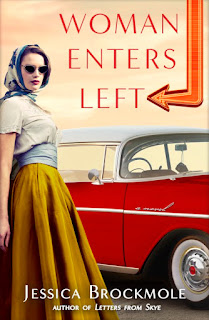Jessica Brockmole is the author of the new novel Woman Enters Left. She also has written the novels Letters from Skye and At the Edge of Summer and contributed to the anthology Fall of Poppies. She lives in northern Indiana.
Q: How did you come up with
the idea for Woman Enters Left, and for your character Louise?
A: When researching and
writing historical fiction, I always have more material than I can use in the
work-in-progress. Uncovered history, unused bits of research, and unexpected
ideas all get jotted on blank index cards and tucked into a box.
When I’m brainstorming a new
novel, I pull out my cards, spread them out, and pull together ones that could
make a whole story.
Woman Enters Left was the
intersection of a few of those cards. Golden Age Hollywood, the House
Un-American Activities Committee, Route 66, road travel in the 1920s, the
Radium Girls. I plucked these index cards from my stack and thought of how I
could tie them all together to make what I hope is a compelling story.
I knew my main narrator would
be from the ‘50s and would be from Hollywood, but the story of her genesis
isn’t very complex. Louise strode fully-formed into my imagination and demanded
I give her a car and a road map. I was happy to oblige!
Q: The book includes so many
details from the 1920s as well as the 1950s. What kind of research did you do
to recreate those time periods, and did you learn anything that especially
surprised you?
A: I researched the 1920s and
1950s largely through the words of the people who lived them. I looked at maps,
travel guidebooks, magazines, advertisements, postcards, automobile manuals,
and budget books.
I researched the Radium Girls
through medical reports and court proceedings. I read newspaper accounts of the
Red Scare, blacklisting, and HUAC trials, as well as communications by those
affected.
I pulled these different
types of documents into the novel’s narrative. If I’d learned my characters’
stories through these documents, why not tell them through the same (but
fictional) documents?
Q: Louise travels eastward
across the United States in 1952, while her mother made the reverse journey in
1926. Why did you decide to focus on these road trips, and what do you think
they say about the characters?
A: I’ve been fascinated by
the National Old Trails Road—the almost forgotten older sister of the Mother
Road herself, Route 66—and impressed by the intrepid adventurers who set off
across her in the 1920s, before motels, before frequent diners and gas
stations, even before regular paving.
[I wanted] to compare these
brave and adventurous travelers of the ‘20s to those of the ‘50s, driving their
boats with the comforts of radio, air conditioning, and regular Shell stations
along the way.
It’s a contrast to be mined
and one to help define my two sets of travelers—the reserved, steady, and
privileged Louise, and, those decades earlier, Ethel and Florrie and their
breathless boundary-pushing, both on the road and in their friendship.
Q: How was the book's title
chosen, and what does it signify for you?
A: Woman Enters Left was the
title that I always had on my working drafts and, after a lot of brainstorming
and shooting potential titles back and forth, we decided to stick with that
working title.
Not only does Woman Enters
Left suggest the film and screenwriting aspect of the story, being a stage
direction, but it also symbolizes Louise “entering” the story from the
geographical left.
Q: What are you working on
now?
A: I’m working on something
inspired by some research I’ve done on single women and the magazine industry in
the 1920s, but I’m not far enough into it to reveal much more than that. I hope
to be able to say more about this project soon!
--Interview with Deborah Kalb




No comments:
Post a Comment